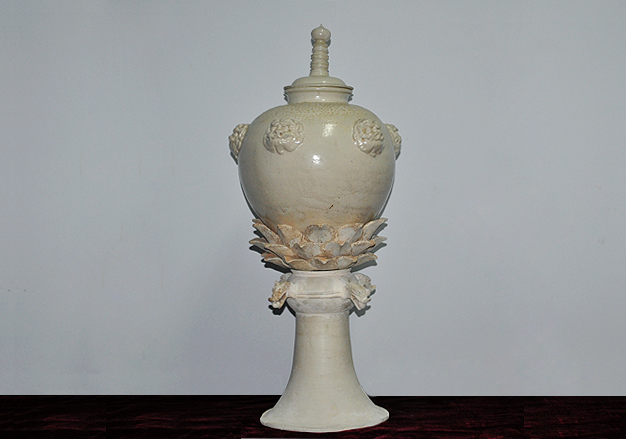
The Pagoda Pot of the Tang Dynasty consists of two parts from top to bottom. The upper part is a white-glazed porcelain pot with decorative lion-heads and one pagoda-shaped lid (Fig.1). The body of the pot is a sphere, onto whose belly six equally spaced lion-head figurines are moulded for decorative purpose. The upper part is covered with white glaze except for the bottom. The lower part is a painted white pottery lotus stand ornamented with dragon heads (Fig.2). It is made up of two sub-parts, i.e., the stand and the lotus flower-shaped supporting tray. The stand resembles a trumpet placed upside down, and its upper part is decorated with four moulded dragon heads each of which holds a pearl in the mouth. The supporting tray, roughly round, looks like a lotus flower comprising three layers of red painted petals and most of the colour has faded.
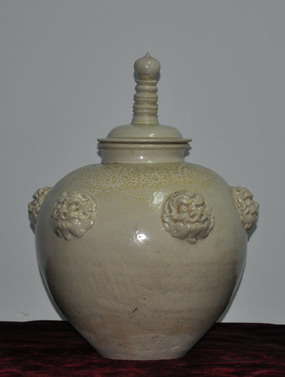
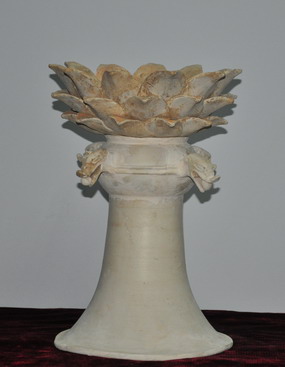
Representative pagoda pots that have been unearthed include:
The pottery pagoda pot unearthed in the Tang tombs in the western suburb of Wuzhong, Ningxia (Fig.3). Its lid consists of two parts, i.e., the lid shaped like an inverted bowl and Tasha(a pagoda-like handle). On the lid that looks like an inverted deep-belly bowl there stands the Tasha comprising a hollow “transmigration wheel” (xiang-lun) and a lotus throne. The pot features a broad mouth with a round everted rim. Below the rim comes the short neck and further below, a deep belly which gradually tapers into a small flat bottom. At the shoulder there are three identical beast faces moulded for decorative purpose. The stand is made up of the spittoon-like upper part and the lower part resembling an inverted deep-belly bowl. The two parts are glued together.
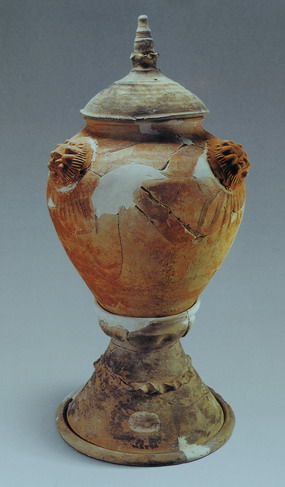
The pottery pagoda pot unearthed from a Tang tomb in the western suburb of Wuzhong, Ningxia (Fig.4). The “transmigration wheels” were made separately and then glued together to form the lid knob on the centre of the inverted-bowl-shaped lid disc. At the top of the knob there is a pearl. The pot, decorated with beast faces, features a contracted mouth with a round everted rim. Blow the rim is a short neck and then further blow, a round protrusive belly that gradually tapers into a flat bottom. On the belly, there is a pair of elephant faces and a pair of beast faces. Each pair is arranged in such a way that the two identical faces look in opposite directions. The upper part of the stand resembles a spittoon whereas its lower part looks like an inverted basin.
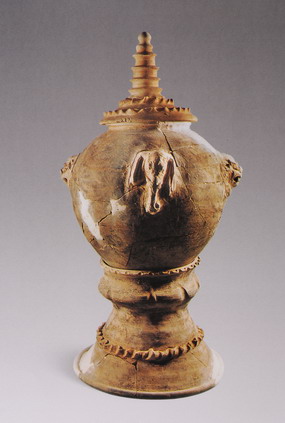
The pottery pagoda pot unearthed in a Tang tomb in the western suburb of Wuzhong, Ningxia (Fig.5). The pagoda-shaped lid consists of the “transmigration wheels” and the round canopy-shaped knob which were processed separately and then glued together. The pot decorated with beast faces features a contracted mouth with a rim resembling a series of petals. Below the rim is the round shoulder and then a round protrusive belly that gradually tapers from the middle into a small flat bottom. There are four moulded beast faces at the shoulder, which are not evenly spaced. The stand is also made up of two parts processed separately. The spittoon-shaped upper part is fitted into and glued to the lower part shaped like an inverted basin.
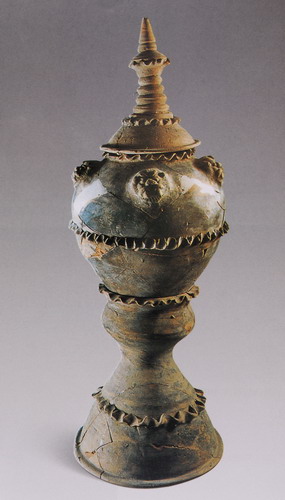
The painted pagoda pot of the Tang Dynast[5] unearthed at Beiyaowan, Gongyi, Henan Province (Fig.6). The pot features a “straight mouth” (zhi-kou) with a curved rim; a short plump shoulder; a round protrusive belly; and a flat bottom. It is covered by a pagoda-like lid and rests upon a circular-footed and trumpet-shaped stand. In the walls of the circular foot there are four groups of openwork design which are evenly spaced. At the upper part of the stand there is a convex-ridged girdle on which there are five moulded dragon heads, each of which holds a round pearl in its mouth. The top of the stand is a seven-petal lotus flower in full bloom, which supports the pot.
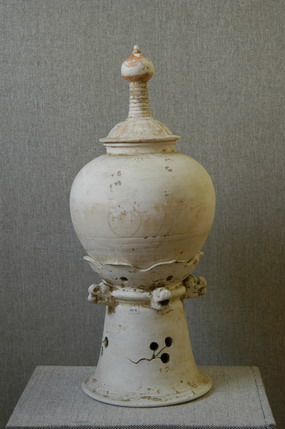
The blue and white porcelain pagoda pot[6] unearthed in the coffin chamber of a Tang tomb in Xiawo Town, Shangjie District, Zhengzhou City (Fig.6). With a total height of 44cm, it features a pagoda-like lid, a broad mouth with a round rim, a “girdled” neck, a round shoulder, a curved wall and a flat bottom. It rests on a bowl-like stand with an inverted trumpet-shaped foot. On the lid there are blue grass leaves and swastikas under the glaze. At the shoulder of the pot, there are two circular series of convex strings. Under the glaze of the pot there are peonies, tufts of curled grass leaves, and flower bouquets. In addition, there is also a standing child holding a handled hook who looks as if he is beating the round ball below.
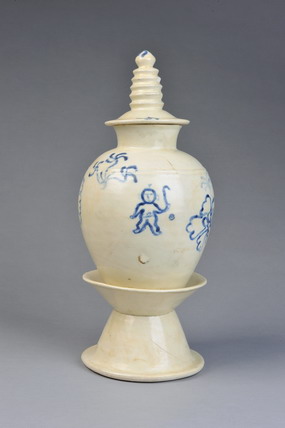
An overview of the evolution of the pagoda pots that have been unearthed has shown: that the knob/handle of the lid had evolved from the solid, thin, high handle to the hollow and short knob, whose final form was the peach-shaped knob; that the lid had transformed from the earlier shape of the shallow plate to the common shape of the inverted bowl; that the stand had evolved from the girdled design to the shape of the low inverted basin; that as the thickest place of the belly moved downward, the pot became increasingly slender; and that the decoration had changed from simplicity to elaborateness and then reverted to simplicity and realism. As for the pagoda pot introduced in this paper, it can be dated back to the late mid Tang Dynasty if we examine its shape and adopt the dating criteria for pagoda pots unearthed in Tang tombs.
What on earth was the use of pagoda pots interred in Tang tombs?
Your answer please, if you have any questions or answer, please feel free to send us email, we are waiting for your answers and participation, and your comments, answers and suggestions will be highly appreciated. We will select and publicize the most appropriate answers and comments some time in the future.
Weekly Selection Email: meizhouyipin@chnmus.net
How was the Pagoda Pot of the Tang Dynasty
in the Collection of Henan Museum Restored?
This pagoda pot had been exhibited separately in Gongyi Museum as two items, i.e., the white-glazed pot with a pagoda-like lid and decorative lion heads, and the white pottery lotus lamp before it was transferred in 1997 to Henan Museum, where they remained separately on display in the Hall of Sui and Tang Dynasties for Light of Ancient Civilizations in Henan, a basic exhibition of Henan Museum. Later, a lot of relevant documents on archaeology brought to light material evidence for this special pagoda pot. The full and accurate data accumulated in archaeological excavations also proved that the two pieces should be combined together as a pagoda pot. Based upon these new findings, the author has assembled the white-glazed pot with a pagoda-like lid & decorative lion heads and the painted white pottery lotus lamp. It turns out that they fit perfectly. In this way a complete pagoda pot made up of a lid, a pot decorated with beast faces and a stand has been presented to the world. After being assembled, the pagoda pot is as high as 65 centimetres in total.
